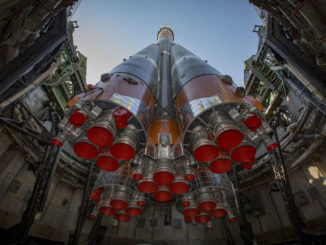
A rocket booster SpaceX used to launch a planet-hunting NASA observatory two months ago fired again Saturday at Cape Canaveral, clearing a major pre-flight checkout before blastoff June 29 with a space station supply ship.
After running the rocket through a mock launch countdown, SpaceX engineers oversaw the brief ignition of the Falcon 9’s first stage Merlin engines at 5:30 p.m. EDT (2130 GMT) Saturday on Cape Canaveral’s Complex 40 launch pad.
Hold-down restraints at pad 40 kept the rocket firmly on the ground as the first stage’s nine Merlin 1D engines throttled up to more than a million pounds of thrust.
A few seconds after igniting, the engines appeared to switch off as planned. A plume of steam and rocket exhaust loomed over pad 40 as SpaceX ensured the Falcon 9 transitioned into a safe condition after the hotfire test, a customary milestone in all SpaceX launch campaigns.
SpaceX confirmed the successful hold-down firing in a tweet later Saturday evening, confirming plans to launch the rocket at 5:42 a.m. EDT (0942 GMT) on Friday, June 29.
The Falcon 9 launching next week will use the same first stage that carried NASA’s Transiting Exoplanet Survey Satellite toward orbit on an April 18 launch from Cape Canaveral. The turnaround of some 10 weeks between missions is set to be the shortest span between launches of the same recycled Falcon 9 booster.
The first stage was the final one manufactured by SpaceX using the company’s discontinued “Block 4” configuration. SpaceX debuted the upgraded “Block 5” version of the Falcon 9 rocket May 11.
The Falcon 9 Block 5 design is optimized for reusability of the first stage, and SpaceX founder and chief executive Elon Musk said the upgraded Block 5 boosters could be launched, landed and flown again in as little as 24 hours, eventually requiring little more than the cost of new propellants and processing costs.
The Block 4 configuration was not capable of such rapid re-flights, requiring disassembly of its landing legs, inspections, refurbishment and the installation of new heat shield material and grid fins used on descent. The work took time and cost millions of dollars, but SpaceX officials said the expense of refurbishing Block 4 boosters was less than the cost of manufacturing an all-new vehicle.
The first stage that launched NASA’s TESS mission in April landed on SpaceX’s drone ship in the Atlantic Ocean, then returned to Port Canaveral, where engineers removed it from the recovery vessel and transported it to a hangar to begin preparations for its next mission.
The June 29 launch will be SpaceX’s 12th mission of the year, and the 15th flight under the company’s multibillion-dollar cargo transportation contract with NASA.
The Dragon supply ship set to ride the Falcon 9 rocket into orbit next week is also reused from a previous flight in 2016. With the completion of the static fire test Saturday, teams at Cape Canaveral will lower the Falcon 9 rocket and return it to the hangar at pad 40, where they will mate the launcher with the Dragon cargo capsule.
The commercially-managed resupply mission will deliver more than 5,900 pounds (about 2,700 kilograms) of research hardware, crew supplies and spare parts to the International Space Station’s six-person Expedition 56 crew.
The equipment launching to the space station next week includes a spare Canadian-built latching end effector for the research lab’s robotic arm, plus an instrument developed by NASA’s Jet Propulsion Laboratory to be mounted outside the station’s Japanese Kibo lab module to measure the temperature of plants from space.
The temperature measurements will tell scientists about the health of the plants, how much water they are using, and the resiliency of crops to extreme conditions like heat waves and droughts.
“When a plant is so stressed that it turns brown, it’s often too late for it to recover,” said Simon Hook, ECOSTRESS principal investigator at JPL. “But measuring the temperature of the plant lets you see that a plant is stressed before it reaches that point.”
The Dragon capsule is scheduled to arrive at the space station Monday, July 2, to begin an approximately month-long stay. The craft will detach, de-orbit and splash down in the Pacific Ocean at the end of its mission, bringing experiment specimens and other payloads back to Earth.
Email the author.
Follow Stephen Clark on Twitter: @StephenClark1.



